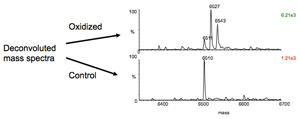Determining molecular weights of proteins by ESI
While for many ions n=1, for proteins n can be a large number. For instance, when albumin (molecular weight ~67 kDa) is sprayed in dilute formic acid, it can attract as many as 60 protons which charge its arginine and lysine groups. This leads to a mass-to-charge ratio (m/z) of 67,000 to 60, i.e., a m/z of 1166.67. A single protein gives rise to a series of different charge states. By observing the [n] and [n+1] charge states, simultaneous equations can be solved to obtain the molecular weight of the protein. If the m/z values of two successive [n] and [n+1] ions are x and y, then two equations can be written:
(1) x = (M+n)/n
(2) y = (M+n+1)/(n+1)
These equations are easily solved such that n = (y-1)/(x-y). This value of n can be substituted into equation (1) to solve for M. Note that n should be an integer.
More sophisticated software can utilize the entire spectra of a sprayed protein to refine not only the molecular weight of the protein, but also any minor modifications of the protein that may be present. In the example below, there are two ESI-MS spectra of aprotinin, the upper one that had been oxidized by singlet oxygen (1O2) and the lower one from an unoxidized control. Three ion states can be seen; those for oxidized aprotinin are about 2 m/z larger and are "furry".

When these spectra were deconvoluted, the control aprotinin was resolved into a single peak of mass 6510 Da, whereas the oxidized sample resolved into three peaks; the unmodified aprotinin and two others that were increased by 16 and 32 Da.

Depending on the mass accuracy of the mass analyzer, the molecular weight of the protein can be determined with high precision.



